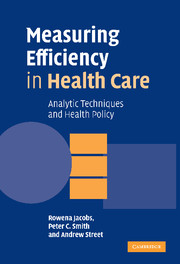Book contents
- Frontmatter
- Contents
- List of figures
- List of tables
- Preface
- Acknowledgements
- List of abbreviations
- 1 Efficiency in health care
- 2 The components of an efficiency model
- 3 Stochastic frontier analysis of cross-sectional data
- 4 Stochastic frontier analysis of panel data
- 5 Data envelopment analysis
- 6 The Malmquist index
- 7 A comparison of SFA and DEA
- 8 Unresolved issues and challenges in efficiency measurement
- 9 Some alternative approaches to measuring performance
- 10 Conclusions
- Appendix: Data description
- References
- Author index
- Subject index
9 - Some alternative approaches to measuring performance
Published online by Cambridge University Press: 10 December 2009
- Frontmatter
- Contents
- List of figures
- List of tables
- Preface
- Acknowledgements
- List of abbreviations
- 1 Efficiency in health care
- 2 The components of an efficiency model
- 3 Stochastic frontier analysis of cross-sectional data
- 4 Stochastic frontier analysis of panel data
- 5 Data envelopment analysis
- 6 The Malmquist index
- 7 A comparison of SFA and DEA
- 8 Unresolved issues and challenges in efficiency measurement
- 9 Some alternative approaches to measuring performance
- 10 Conclusions
- Appendix: Data description
- References
- Author index
- Subject index
Summary
Introduction
In the preceding chapters we have raised a number of concerns about the use of both parametric and non-parametric methods to draw conclusions about the relative efficiency of health care organisations. Many of these concerns relate to the fundamental problem of trying to derive a composite measure of organisational performance in contexts where multiple objectives are pursued or multiple outputs produced. Other concerns relate to the difficulty of formulating a coherent model of the production process and of ascertaining what constitute the environmental constraints that each organisation faces.
In this chapter we consider some alternative approaches to analysing the performance of health care organisations that seek to address some of these issues. We must emphasise that these approaches are experimental, and address only some of the concerns raised in the preceding chapters. However, they do illustrate that, depending on the purpose of the analysis, the potential exists to use a wider range of analytic tools than traditionally recommended in the efficiency literature.
The techniques discussed in this chapter address two distinct issues: the hierarchical form into which most health systems are organised, and the pursuit of multiple objectives when there is little consensus as to their relative priority. To this end, in section 9.2 we describe how multilevel modelling can be used to gain insights into the impact of different hierarchical levels on specific aspects of performance. Section 9.3 then examines the potential for using seemingly unrelated regressions to model simultaneously a set of multiple performance measures.
Information
- Type
- Chapter
- Information
- Measuring Efficiency in Health CareAnalytic Techniques and Health Policy, pp. 179 - 206Publisher: Cambridge University PressPrint publication year: 2006
